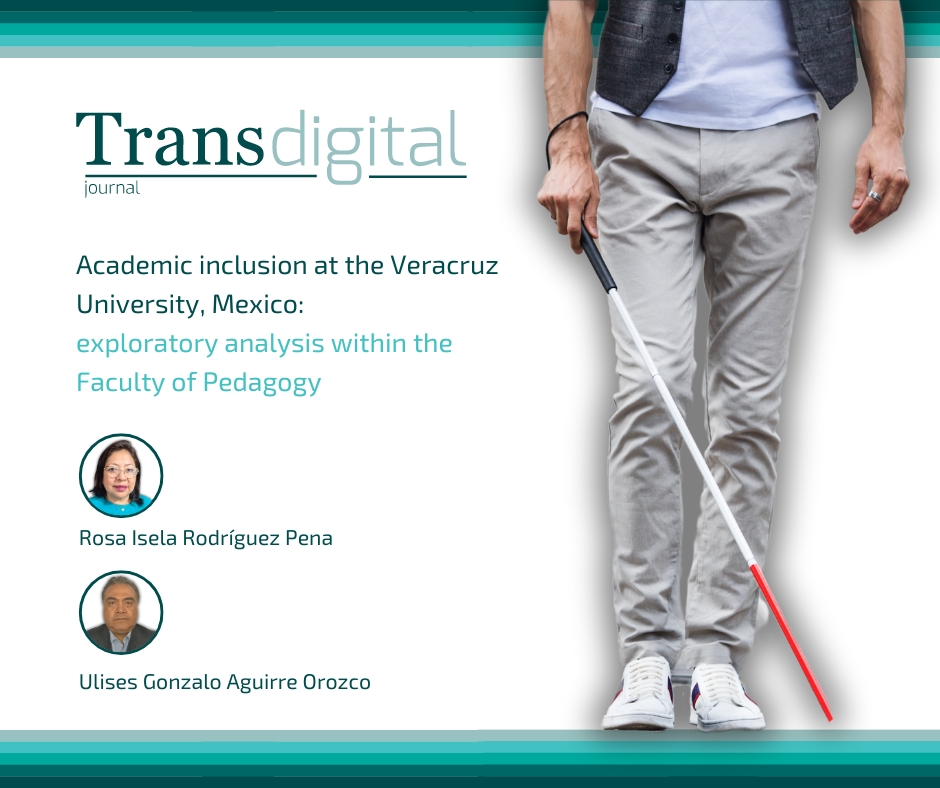Academic inclusion at the Veracruz University, Mexico: exploratory analysis within the Faculty of Pedagogy
DOI:
https://doi.org/10.56162/transdigital345Keywords:
academic inclusion, higher education, academic perceptions, teaching practice, institutional inclusionAbstract
Academic inclusion guarantees equity and participation of all individuals. The Faculty of Pedagogy of the Veracruz University, Mexico, trains professionals in promotion and inclusive education. This study examined the dynamics of faculty scholars through a quantitative approach to explore perceptions, experiences, and institutional policies related to inclusion. To collect information, a questionnaire of 32 questions was created. Five areas were addressed: eliminating barriers to learning, promoting the participation of all, developing specific capabilities, cooperative work with students, and Universal Design for Learning. The questionnaire was applied to 19 professors to obtain significant data on inclusion in the faculty. The individual and institutional factors that influence academic inclusion were analyzed. In addition, the physical, social, and cultural barriers that affect inclusion were examined and the importance of inclusive policies, teacher training and flexible curriculum design was highlighted to promote an equitable and accessible educational environment.
References
Ainscow, M. (2005). El próximo gran reto: la mejora de la escuela inclusiva [Presentación de apertura]. Congreso sobre Efectividad y Mejora Escolar, Barcelona, España.
Bandura, A. (1977). Self-efficacy: Toward a unifying theory of behavioral change. Psychological Review, 84(2), 191–215. https://doi.org/10.1037/0033-295X.84.2.191
Booth, T. (2011). The name of the rose: Inclusive values into action in teacher education. Prospects 41, 303–318.
Bronfenbrenner, U. (1981). The ecology of human development: Experiments by nature and design. Harvard University Press.
Cascaes da Silva, F., Gonçalves, E., Valdivia Arancibia, B. A., Graziele Bento, G., da Silva Castro, T. L., Soleman Hernandez, S. S., & da Silva, R. (2015). Estimadores de consistencia interna en las investigaciones en salud: el uso del coeficiente alfa. Revista Peruana de Medicina Experimental y Salud Pública, 32(1), 129-138.
CAST (2018). Universal Design for Learning Guidelines version 2.0. Wakefield, MA.
Hall, E. (2005). The entangled geographies of social exclusion/inclusion for people with learning disabilities. Health & place, 11(2), 107-115.
Johnson, D. W., & Johnson, R. T. (1989). Cooperation and competition: Theory and research. Interaction Book Company.
Lévy Manquin, J. P., Varela Mallou, J., & Abad González, J. (Coords.) (2003). Análisis multivariable para las ciencias sociales. Pearson Educación.
Nieto, A. (2000). Las grafías alternativas pianísticas: defensa para su inclusión en el conservatorio. Música y educación: Revista trimestral de pedagogía musical, 13(44), 97-108.
Sen, A. (1999). Desarrollo y libertad. Planeta.

Downloads
Autor de correspondencia
El autor de correspodencia se identifica con el siguiente símbolo: *Published
How to Cite
License
Copyright (c) 2024 Rosa Isela Rodríguez Pena, Ulises Gonzalo Aguirre Orozco

This work is licensed under a Creative Commons Attribution 4.0 International License.
All articles in Transdigital are licensed under a Creative Commons Attribution 4.0 International License. Authors hold the copyright and retain publishing rights without restrictions.









